Pruning hydrangea in spring
Incomparable hydrangeas have always been popular with gardeners and summer residents because of their luxurious inflorescences of various colors, as well as their ability to create beautiful landscapes on the site. Some of them can curl like vines, others are in the form of a bush or tree, but they all bloom luxuriously and smell sweet in the summer. But it should be noted that it takes a lot of effort to achieve such beauty by the summer, since the plant needs care and, of course, proper seasonal pruning.
Well, below you will learn how to properly prune hydrangeas in the spring.
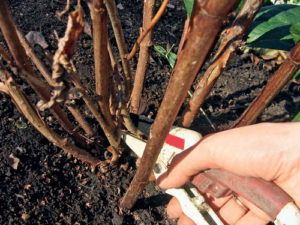
Content
- 1 When to prune hydrangeas: advantages and disadvantages of spring pruning
- 2 When to prune in the spring: what month, timing
- 3 General rules and tips for correct spring pruning
- 4 Step-by-step instructions, diagrams and features of pruning hydrangea varieties in spring: types of spring pruning
- 5 Leaving after spring pruning
- 6 Popular mistakes during the pruning procedure
When to prune hydrangeas: advantages and disadvantages of spring pruning
The pruning procedure is a rather delicate matter, it requires adherence to some important points.First of all, it is worth understanding when it is still better to prune hydrangeas - in spring or autumn.
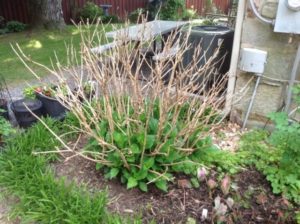
In most cases autumn manipulations with hydrangea can be fraught, they can lead to diseases, a decrease in the frost resistance of the plant. Moreover, the cuts themselves may not be tightened at the right time, which will lead to freezing of the bush branches. Usually, already dried flowers are cut in the fall - this is quite safe, since it does not lead to the formation of wounds at the cut sites. In addition, in winter the inflorescences will lower the branches of the hydrangea downward, which can break or deform the branches and the entire shrub as a whole.
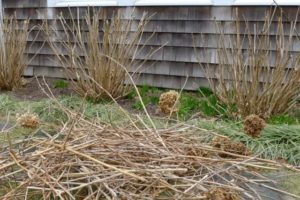
In the spring, pruning of hydrangeas is carried out in a short time, since it is carried out mainly until the moment when the juice flows through the bush. The main manipulations with hydrangea are carried out precisely in the spring period, although there are also advantages and disadvantages here.
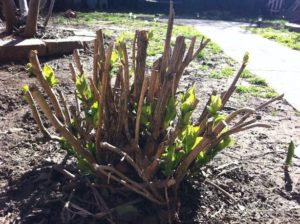
Benefits spring pruning hydrangea:
- Appearance. By pruning a bush in the spring, you will certainly improve its appearance, create a more correct, desired bush shape.
- Abundant flowering. By cutting off dried branches, you stimulate the growth of new, young ones, which will give out more inflorescences of larger, brighter ones.
- The correct choice of branches to cut. In spring, it is much easier to separate living branches from dying ones, which should be removed for the hydrangea to grow and stay healthy. They can be easily identified by their color, as well as slightly swollen buds.
- No risk of freezing. By pruning hydrangea branches in the spring, you do not run the risk that the cuts may be damaged by winter frosts, as is the case with autumn pruning. However, the cuts need to be powdered with charcoal powder in the fall and spring as this works as an antiseptic to stimulate new shoot growth.
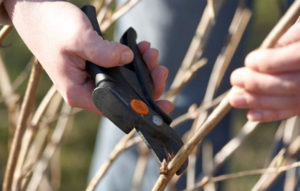
disadvantages pruning hydrangea in spring:
- Short time. In the spring, as a rule, pruning is done during a dormant period, before the sap flow in the plant begins, because a little late with this, you run the risk of seriously harming the shrub or completely depriving yourself of the opportunity to enjoy the wonderful flowering of the unique hydrangea.
- Time to grow. Having cut off the necessary branches, you will not immediately get young inflorescences on new shoots. You will have to wait until the end of the season to see the fruits of your handiwork, although this can happen much faster.
- Growth phases. A little later than the set, cut branches in the spring can radically shift all phases of plant growth and, thus, the hydrangea will not be able to ripen, and also fully prepare for winter. This will make it vulnerable to frost, which can even lead to the death of the bush.
When to prune in the spring: what month, timing
Usually, the main types of pruning of hydrangeas are made precisely in early spring, when the ground is still covered with a thin layer of snow, but it is important to take into account several points that will help to carry out the procedure correctly, without harm to the plant.
- Work needs to start only from the moment the growth buds swell, since they are the right guide in the selection of branches that need pruning. This process usually falls in March or early April.

- An important factor in pruning is weather. You can not start work if the kidneys are swollen, and the cold has resumed. The procedure should be postponed a little until more favorable days until the end of April, but it is not worth delaying too much, since the plant will not have time to fully develop flowering growths in its typical terms.
- Know the type of hydrangea, the features of which also affect the timing of trimming. The tree-like beauty needs to be pruned as early as possible (March), since it grows more slowly, requires a sufficient amount of time to form young shoots than the paniculate one. She (paniculate), in turn, loves later pruning (April), but large-leaved is pruned in early spring, but according to a special scheme, since it blooms on last year's shoots.
General rules and tips for correct spring pruning
After a suitable day and spring month has been chosen for pruning hydrangeas, you must use the basic rules for high-quality flowering plant pruning:
- an adult bush or tree at first thinned out;
- weak branches are removed palm-width from the ground;
- trimmed extra shoots growing inside the bushthat give unwanted shadow;
- produced removal of frozen branches up to the beginning of healthy wood;
- garterafter fixing the cut plant on a suitable support in the form of an iron or wooden pole.
Important! Before you cut anything off, first of all you need to know the name and type of hydrangea that lives in your garden, as this information will help in proper care, save you from unnecessary problems and frustration.
Hydrangeas are divided into two main groups:
- Hydrangeas blooming on last year's shoots (large-leaved, oak-leaved, liana-like, serrate).
- Hydrangeas blooming on the shoots of the current year (paniculate, tree-like).
Note! Plants of the first group are pruned quite modestly, while removing only old dried inflorescences, as well as weak shoots that have poorly endured the winter. Standard rules do not apply to them, since they deprive the plant of the ability to bloom.
Step-by-step instructions, diagrams and features of pruning hydrangea varieties in spring: types of spring pruning
Having found out that each individual type of hydrangea has its own characteristics and tolerates certain types of pruning in different ways, it is necessary to understand in more detail about each of them.
Tree variety
Treelike hydrangea is pruned in spring and autumn according to the following schemes, using certain types of pruning.
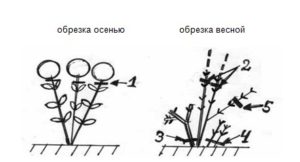
- Removal of globular inflorescences.
- Sanitary pruning - removing broken, dead ends of branches.
- Anti-aging - complete removal of old branches.
- Thinning - cutting off zero shoots that are incapable of flowering, which only take away strength from a flowering bush.
- Flowering pruning - Pruning last year's shoots by about four pairs of strong buds.
Video: spring pruning hydrangea tree
By the way!A similar scheme and types of spring pruning are also applied to varieties such as ash, motley hydrangea.
Paniculata variety
The panicle hydrangea is pruned in spring and autumn according to the following schemes, using certain types of pruning:
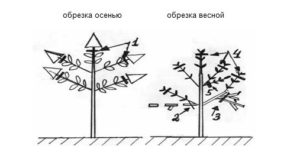
- removal of cone-shaped inflorescences;
- sanitary pruning - cutting only dried branches, since this species is resistant to cold weather, shoots do not freeze;
- rejuvenating procedure - involves cutting branches with damping growth, as it bears a resemblance to a tree, has a skeletal trunk and branches;
- shortening of shoots for the growth of large young inflorescences;
- thinning pruning - removing excess shoots to avoid thickening and shading of the tree.
Video: spring pruning hydrangea paniculata
Note! Of the three or four new shoots growing from one bud, at least one should be cut off, while choosing the one that grows inside the bush.
Large-leaved variety
Large-leaved hydrangea is pruned in spring and autumn according to the following schemes and using certain types of pruning:
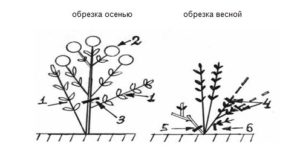
- preservation of new shoots that did not bloom;
- removal of only two-year-old faded branches;
- moreover, pruning of large shoots (2) is carried out up to the outgoing new branch (1);
- sanitary pruning - a cut of dead, frozen, damaged branches;
- anti-aging pruning - a cut of perennial branches;
- thinning pruning - a cut of small weak shoots.
Video: spring pruning large-leaved hydrangea
Worth knowing! Pruning hydrangeas for flowering in the spring is done only if it was not done in the fall.
Leaving after spring pruning
Having successfully passed the stage of spring pruning of your shrub or tree, the next procedure should be to designate competent, consistent care of the hydrangea.
First of all, you need to organize timely plant feeding, which will stimulate the rapid growth of strong beginners, but a long thin growth unsuitable for flowering can be avoided. Fertilizers of a mineral nature will be the best helpers.
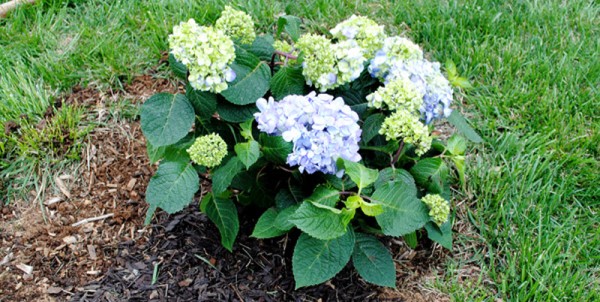
Mulch the soil any material suitable for this (manure, compost, etc.) is the second important stage of care. This will help strengthen metabolic processes in the roots, create additional protection against pests and weed growth. The layer of such a shelter should be at least 5-6 cm in height.
Abundant, regular watering - a guarantee of a luxurious crown and a lush, unique flowering of hydrangea. As new growth progresses, young branches should be tied up, as they do not always withstand new large flowers and may break under their weight.
Popular mistakes during the pruning procedure
In order to avoid oversight and not to destroy the plant, you should pay attention to the most frequent mistakes that amateurs often tend to make while carrying out this kind of work.

Popular mistakes when pruning hydrangeas in spring are:
- Incorrect pruning time almost always leads to a slowdown in the growth of hydrangea, as well as its poor and unremarkable flowering.
- Failure to comply with the rules, sequence, mode of procedure entails the formation of unsuccessful forms of the bush, its total overgrowth or death.
- Ignoring recommendations for each individual variety hydrangeas can destroy the plant even before its expected full life and development begins.
- Incompetence as to name and type the acquired seedling also leads to serious errors in the further care and development of the specimen.
- Lack of any care at all behind a plant is simply unacceptable when it comes to the vulnerable beauty of hydrangea.
In conclusion, I would like to say that by growing a unique hydrangea on your plot or garden, you will get maximum emotions and impressions from its beauty, which will not allow you to be lazy and ignore its presence. Hands reach out to do something special and necessary for her, and the seasonal spring pruning of hydrangeas will become a completely familiar, favorite thing for you.


Good evening! Very helpful article. I realized my mistakes when pruning hydrangea. This year, I hope, to get an abundant flowering of bushes, if only the weather did not lead. Thank you!
Hello, great article for beginners, I have never encountered this plant before, I hope your advice will be useful to me in the future.
But one more question begs me, the answer to which I did not find here. My shrubs are planted in large flowerpots, the plant is already two years old, there are old fruitful shoots, as well as many new ones on which inflorescences have formed. The plant began to bloom in May and by July the flowers have a feeling that they have faded, lost their bright color and became withered, spoiling the appearance of the whole broadleaf bush. Is it possible to remove these ugly caps? If on the same shoots new ones begin to start, which come from the base a little lower? Or if I remove the caps in my opinion that have faded, the plant will not bloom further?
Make it clear for me please
Now it's July and I have such a situation
Hello Marina!
In any case, if you simply remove the caps that have already faded, this will not in any way affect their re-flowering (but it is better to remove the entire branch completely, i.e. the entire branch up to the outgoing new shoot - as in the diagram-diagram) since the plant will be able to bloom only on new shoots next year (they must be left behind). Unless, of course, you have a large-leaved hydrangea that can re-bloom from the side buds on the same branches.